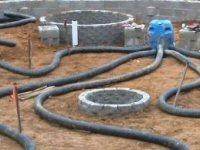The lean to green house has evolved into a Go & Grow House© with a milk jug wall and a pebble rocket mass heater build into the floor. It is planned to be a total standalone passive Greenhouse with a Manual Composting Toilet We still believe that the air exchange rate should be 5 times to insure the plants healthy, but we have not tested it yet.
This feature of the Go & Grow House© uses five key elements necessary for a productive greenhouse: solar input; heat storage; and conservation.
An example of a 12 X 12 Go & Grow House will look when completed
Collecting, converting, and storing is accomplished through the use of:
1. Orientation
2. Glazing
3. Thermal mass
4. Insulation
5. Venting
The Go & Grow House is designed to uses these features to be a off-the-grid self-contained passive solar greenhouse that would only need, soil, sun and water to grow plants,
Orientation - The Grow House takes advantage of the changing angles of the sun throughout the seasons.
The coldest months (winter) the sun heating is increased.
The hottest months (summer) the sun heating is reduced.
The design acts like a thermostat. It produces heat in the winter during clear days. When the seasonal temperatures warm, the structure reduces the solar heating input.
The Winter Sun … The winter sun travels in the southern portion of the sky, rising in the east and setting in the west. Therefore, it is important to face the Go & Grow House’s big windows as close to true south as possible. The path of the winter sun will always be lower in the sky with a shorter path than the summer sun.
Glazing … By using double wall Solexx glazing, with an R 2.1 rating, it is intended by using the Solexx it will eliminate the need for heaters, fuel tanks, and fuel.
Thermal Mass … Rain Water is harvested and is stored in black barrels. Milk jugs are used with permanent water stored in them. They need them for heat storage. Water in milk jugs absorb 90% of the solar radiation. They will hold three times more heat than brick or rock wall Trobe Wall.
This increased heat storage holds night temperature higher longer into the night and will extend the growing season on our Oregon Coast Go and Grow House.
Disposable milk jugs are spray painted flat black and filled with water. When placed in the Go and Grow House on a series of bookshelves.
Milk Jugs want have been known to raise the nighttime temperatures to 39°F with no supplemental heat when outside temperatures dropped to -17°F.
Insulation - Walls and roof that do not collect heat are fitted with insulation to prevent the heat lost. They are fitted with 3 ½” of rigid insulation with an R rating of 21.
Venting – The top windows are designed to vent the hot air on hot sunny days with automatic window openers. Humidity levels are kept low to prevent plant disease.
Moisture – Moisture and mold is a problem in Oregon. Therefore all the walls are built to have air space on both sides of the wall. The outside of walls must have a cavity between the outside surfaces to keep the rain away from the insulation.
Manual Composting Toilet
The second feature of the Go & Grow House© is a toilet option called the Earth Auger©.
The Earth Auger was designed based on work by a retired professor at the University of Washington and is being funded by a Gates Foundation Grant.
This is a pedal-operated dry toilet. Urine is diverted and stored. The faeces is also stored.
The main innovation with the toilet is the mechanized, foot-pedal-actuated dry-flush system and sawdust delivery system that uses no water.
When the pedal is operated, the faeces, paper and sawdust are mechanically processed through a big pipe with an auger inside, which mixes, aerates and moves them through a chamber for storage.
For more details
Human Waste
Pathogens, which are the disease causing organisms, gradually die off during the period of time the faeces stays in the Earth Auger’s storage pipe.
Health organizations suggest about 4 months in warm climates, and possibly 6 months in temperate climates. Storage of faeces is detained in storage for 1-6 months. The time is dependent upon number of uses. The storage container will store 120 uses. Direct handling of excreta by the user is not required as the whole process is pedal-operated until harvest.
At that time of harvest, the material is totally dry. This material can be used on nonfood producing soils.
Urine is high in Nitrogen and is sterile when it exits the body. The separated urine can be used on food producing soil when mixed with 1:10 with water.
A study conducted by the Stockholm Water Company diverted urine from four housing projects to a grain farmer outside the city. The scientists concluded not only that urine could replace quick-acting mineral fertilizers, but also calculated that one adult’s urine provided enough plant nutrients to grow 50 to 100 percent of a person’s food requirements.
Present Status of Project
The floor of the house has been laid and the walls are starting to being built. The fixed floor is 12 feet by 8 feet. The South wall is built to fold up, so it can be transported on a trailer down the highways. It is 4 feet by 12 feet long. When the South wall is folded out the Go and Grow House© will be 12 feet X 12 feet. The metal tubing for the Solexx is installed after the South wall is folded out
The Earth Auger© has been fitted and ready to be installed.
Volunteers are welcome

 1
1

























































